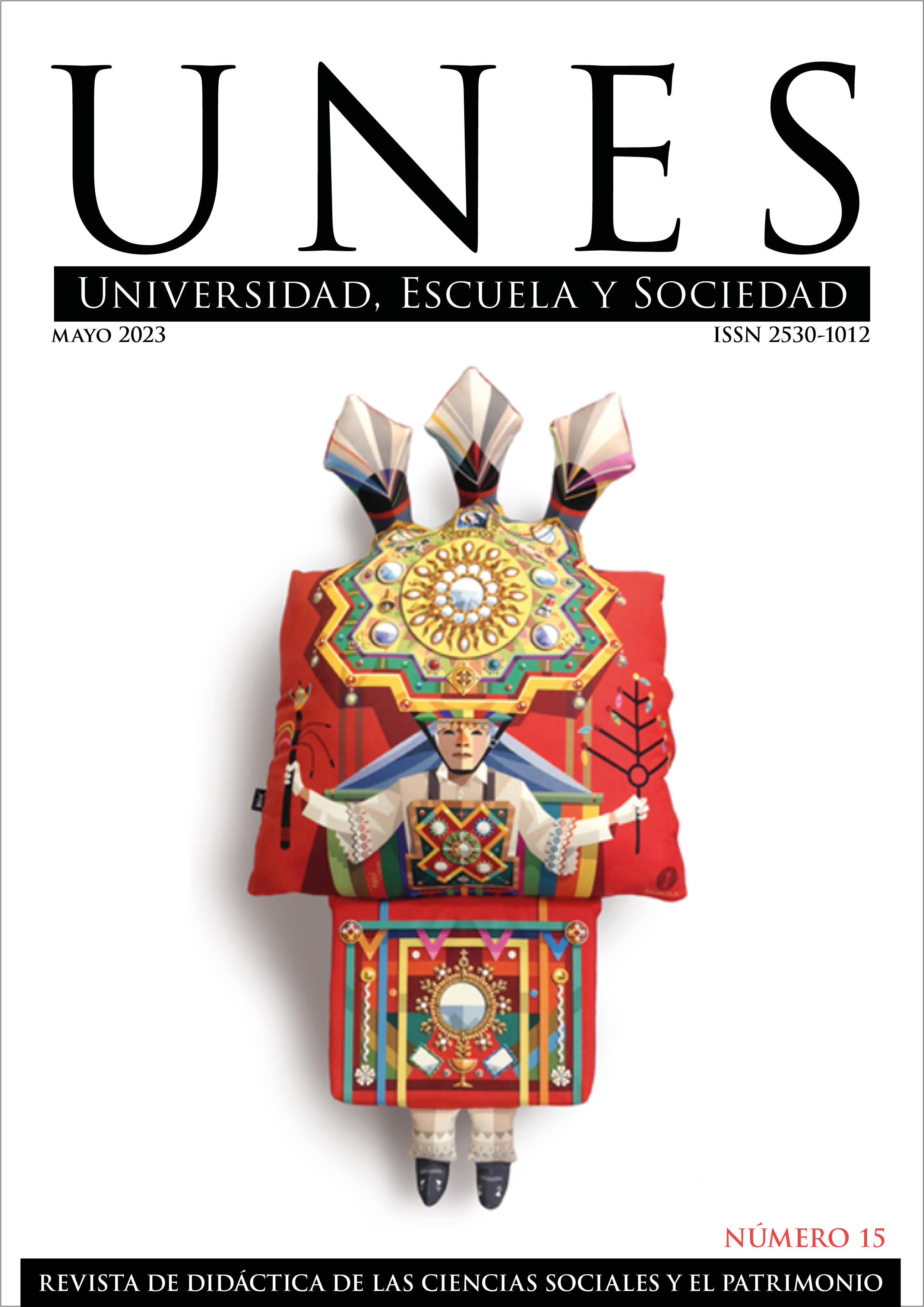Popular characters of cultural heritage as a reference for contemporary packaging design
DOI:
https://doi.org/10.30827/unes.i15.27505Keywords:
intangible heritage, packaging, festive characters, cultural identity, graphic design didacticsAbstract
The heritage festivals in Ecuador keep a series of cultural manifestations, among which are characters loaded with connotative and denotative meanings. Based on which the aforementioned project is argued, whose objective is knowledge and intangible cultural preservation, through a non-heritage technical discipline. Creative aesthetic-functional and symbolic proposals for packaging for various products were generated. The inspirational referents emerge from the popular festive protagonists in the ten provinces of the country. Within the formative research, students of the Graphic Design Career are committed to experimentation, conservation and dissemination of intangible heritage, articulating phases within a technical-creative method. Integrating the investigation, begins with the identification of the problem; the analysis of aspects such as: the target audience, the product, the market, etc.; idea generation; the development of alternatives and finally the realization of models and prototypes. The learning developed was active and collaborative, the student generated his own knowledge, mediated by the research teacher, achieving an intentional approach with intrinsic motivation. The experimental educational environment allowed the integration of identity cultural elements in the design of current products, classified as industrialized. Communicative and pragmatic conventions were broken. The project initially had the intention of making visible and transferring the identity roots, from the generation of visual products developed by the participants, however, it created cultural and emotional links. It resignified the researched and inherited knowledge to be replicated to new audiences, breaking the paradigm regarding the learning of cultural heritage.
Downloads
References
Arcos, D., Pineda, N.& Changuán, K. (2021). Baile de Inocentes. Patrimonio Vivo del Pueblo Sangabrieleño. Gobierno Autónomo Descentralizado del Cantón Montúfar. San Gabriel. Imprenta Portilla.
Bohannan, P. & Glazar, M. (2005). Antropología. Editorial Félix Varela.
Brito, Z. (2008). Educación popular e identidad desde la perspectiva de Paulo Freire. Consejo Latinoamericano de Ciencias Sociales.
Caballero, P., Ramos, R. & López, M. (2012). Ilustraciones infantiles de personajes tradicionales contemporáneos de la serranía ecuatoriana aplicada en una línea de soportes gráficos. [tesis de pregrado, Escuela Superior Politécnica de Chimborazo].
Cabay, I., Correa, N., Endara, P., Larrea, F. & Vieira, M. (2000). Año por año: las fiestas de San Pedro en Ayora-Cayambe, Proyecto Integral Ayora/Abya-Yala, pp.11-12
Cervera, L. (2003). Envase y embalaje. La venta silenciosa. ESIC. España.
Cuenca, J. & Giménez, J. (2013). Patrimonio y Educación: Quince años investigando. En la Educación Patrimonial en la Escuela y el Museo: Investigación y Experiencias, Editorial Jesús Estepa-Guiménez, p.13-24. Universidad de Huelva.
Escobar, T (2009). Introducción. En la fiesta popular tradicional del Ecuador, José Pereira Valarezo, 11-22. Ministerio de Cultura del Ecuador. IPANC.
Escudero, C. (2017). Las fiestas populares en el Ecuador: un factor de interacción comunitaria. Revista Universidad y Sociedad, 9 (3), 27-33.
Fontal, O. & Ibañez-Etxeberria, A. (2015). Estrategias e instrumentos para la educación patrimonial en España. Educación Siglo XXI, 33(1), 15-32
García Linera, A. (2015). Identidad Boliviana: Nación, mestizaje y plurinacionalidad. La Paz: Vicepresidencia del Estado Plurinacional de Bolivia.
García, J. & Tacuri, K. (2006). Fiestas populares tradicionales de Perú. Instituto Iberoamericano del Patrimonio Natural y Cultural.
Ibañez-Etxeberria, A., Fontal, O. & Rivero, P. (2018). Educación Patrimonial y TIC e España: marco normativo, variables estructurantes y programas referentes. Arbor, 194 (788).
López, M., Pomaquero, M. & Solórzano, A. (2021). CGI al servicio de la cultura. Características de los personajes ecuatorianos tradicionales andinos. Revista Internacional de la Imagen. 6(2).
Mayorga, P. (2009). El disfraz. La alteridad entre lo popular y lo marginal. Retrovisor (4).
Mendoza, J. (2018). Empaques, envases y embalajes. El producto y su recipiente. Sello Editorial Javeriano.
Nadel-Klein, J. (1991). Rewiving the Fringe: localism and representation on British etnography in American Ethnologist, 18(3).
Papalia, D., Wendkos, S.& Feldman, R.(2010). Desarrollo humano. Mc Graw Hill.
Pereira, J. (2009). La fiesta popular tradicional del Ecuador. Fondo Editorial del Ministerio de Cultura del Ecuador. p.11.
Pérez Martínez, H. (1998). México en Fiesta. El Colegio de Michoacán/Secretaría de Turismo del Gobierno de Michoacán. pp.25 y 26
Roldán, J. & Marín Viadel, R. (2012). Metodologías artísticas de investigación en educación. Ediciones Aljibe.
Sánchez, J. (1994). Marketing: El Envase. TECSIMA S.A.
Somoza, E. & Gandman, A. (2006). Aprehender El Envase. Nobuko.
Taylor, C. (2009). El multiculturalismo y “La política del reconocimiento”. Fondo de Cultura Económica. p.69
Téllez, A. (2011). La identidad cultural en la adolescencia. Universidad Miguel Hernández. España. Alicante.
UNESCO (Organización de las Naciones Unidas para la Educación, la Ciencia y la Cultura). (2004). Convención para la salvaguardia del patrimonio cultural inmaterial 2003, París. Recuperado el 22 de diciembre de 2022 de www.unesco.org.
Downloads
Published
How to Cite
Issue
Section
License
Copyright (c) 2023 María Alexandra López Chiriboga, Pilar

This work is licensed under a Creative Commons Attribution-NonCommercial-ShareAlike 4.0 International License.
Authors being published in this journal agree to the following terms:
The authors retain their copyrights but guarantee the journal's right to be the first publisher of the work, licensed under a Creative Commons Attribution-NonCommercial-ShareAlike 4.0 International license, which allows others to share the work, provided that they acknowledge its authorship and initial publication in this journal.
Authors may separately subscribe additional agreements for the non-exclusive distribution of the work published in the journal (for example, including it in an institutional repository or publishing it in a book), with recognition of its initial publication in this journal.
Authors are allowed and encouraged to disseminate their work electronically (for example, in institutional repositories or on their own websites) before and during the submission process, as this may result in productive exchanges, as well as more and earlier citations of the works to be published (See The Effect of Open Access) (in English).






 ISSN-e: 2530-1012
ISSN-e: 2530-1012









